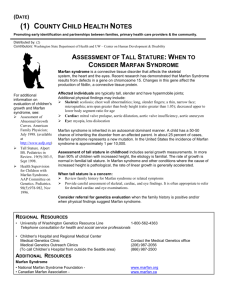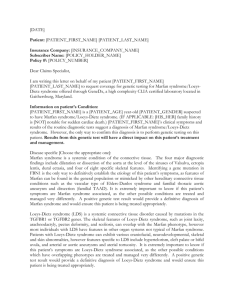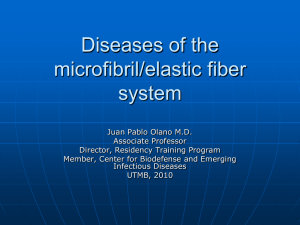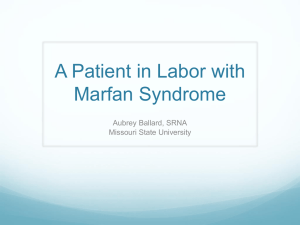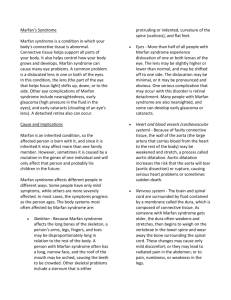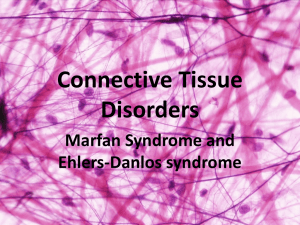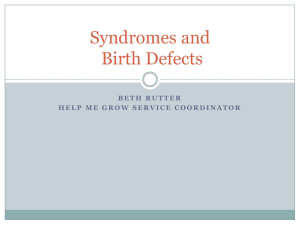Saying `aah` helps unlock a genetic secret
advertisement
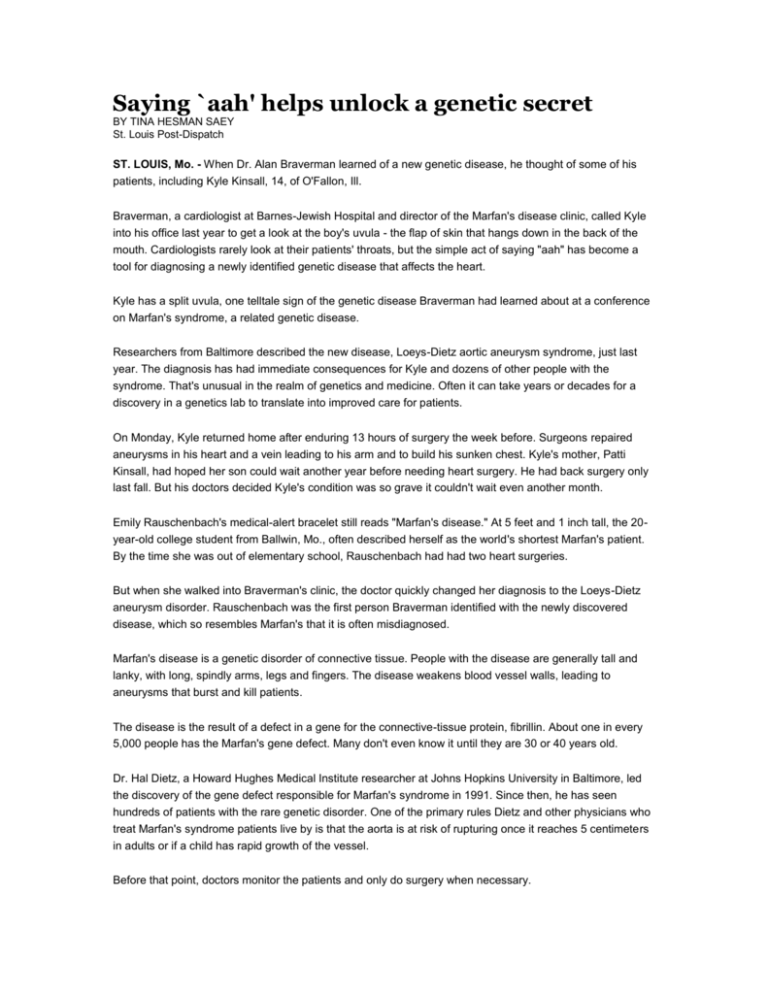
Saying `aah' helps unlock a genetic secret BY TINA HESMAN SAEY St. Louis Post-Dispatch ST. LOUIS, Mo. - When Dr. Alan Braverman learned of a new genetic disease, he thought of some of his patients, including Kyle Kinsall, 14, of O'Fallon, Ill. Braverman, a cardiologist at Barnes-Jewish Hospital and director of the Marfan's disease clinic, called Kyle into his office last year to get a look at the boy's uvula - the flap of skin that hangs down in the back of the mouth. Cardiologists rarely look at their patients' throats, but the simple act of saying "aah" has become a tool for diagnosing a newly identified genetic disease that affects the heart. Kyle has a split uvula, one telltale sign of the genetic disease Braverman had learned about at a conference on Marfan's syndrome, a related genetic disease. Researchers from Baltimore described the new disease, Loeys-Dietz aortic aneurysm syndrome, just last year. The diagnosis has had immediate consequences for Kyle and dozens of other people with the syndrome. That's unusual in the realm of genetics and medicine. Often it can take years or decades for a discovery in a genetics lab to translate into improved care for patients. On Monday, Kyle returned home after enduring 13 hours of surgery the week before. Surgeons repaired aneurysms in his heart and a vein leading to his arm and to build his sunken chest. Kyle's mother, Patti Kinsall, had hoped her son could wait another year before needing heart surgery. He had back surgery only last fall. But his doctors decided Kyle's condition was so grave it couldn't wait even another month. Emily Rauschenbach's medical-alert bracelet still reads "Marfan's disease." At 5 feet and 1 inch tall, the 20year-old college student from Ballwin, Mo., often described herself as the world's shortest Marfan's patient. By the time she was out of elementary school, Rauschenbach had had two heart surgeries. But when she walked into Braverman's clinic, the doctor quickly changed her diagnosis to the Loeys-Dietz aneurysm disorder. Rauschenbach was the first person Braverman identified with the newly discovered disease, which so resembles Marfan's that it is often misdiagnosed. Marfan's disease is a genetic disorder of connective tissue. People with the disease are generally tall and lanky, with long, spindly arms, legs and fingers. The disease weakens blood vessel walls, leading to aneurysms that burst and kill patients. The disease is the result of a defect in a gene for the connective-tissue protein, fibrillin. About one in every 5,000 people has the Marfan's gene defect. Many don't even know it until they are 30 or 40 years old. Dr. Hal Dietz, a Howard Hughes Medical Institute researcher at Johns Hopkins University in Baltimore, led the discovery of the gene defect responsible for Marfan's syndrome in 1991. Since then, he has seen hundreds of patients with the rare genetic disorder. One of the primary rules Dietz and other physicians who treat Marfan's syndrome patients live by is that the aorta is at risk of rupturing once it reaches 5 centimeters in adults or if a child has rapid growth of the vessel. Before that point, doctors monitor the patients and only do surgery when necessary. So when one of Dietz's patients came in with an aortic aneurysm that was only swollen to 3.9 centimeters and had stayed at that level for several visits, he didn't worry. The woman still had a centimeter to go before she'd need surgery. But two weeks after the visit, Dietz got a call. The woman's aorta had ruptured and she died. "It really took my breath away," Dietz said. "In caring for a thousand people with Marfan's, this was the first person I had taken care of that ever died." Dietz began looking for a cause of the woman's death. He sent samples of her DNA for testing and discovered that the woman did not have Marfan's syndrome. The fibrillin gene, which is altered in people with Marfan's syndrome, was perfectly normal in the patient. Instead, the woman had a completely different genetic disease, now named after Dietz and his colleague Bart Loeys. The discovery of the disease is so new that it's unknown how many people have it. One or two people in each Marfan's clinic the researchers visit fit the profile for Loeys-Dietz syndrome, Dietz said. The patients may have long fingers, widely spaced eyes with a bluish tint to the whites, a forked uvula, slightly misshapen heads, cleft palates and twisted, tortuous blood vessels throughout the body. Dietz said he gets five to 10 phone calls a week from physicians who think their patients may have the new syndrome. The syndrome is caused by mutations in either of two genes, called TGFBR1 and TGFBR2, which encode receptors for a major growth factor called TGF-beta. Because the genes influence several different developmental pathways, mutations can cause problems in many different parts of the body. Doctors now operate before an aortic aneurysm reaches 4 centimeters. Patients get whole-body scans to detect blood vessels ready to burst elsewhere in the body. Only heart aneurysms plague people with Marfan's syndrome, but a person with Loeys-Dietz syndrome may die from an aneurysm in the brain or leg or anywhere else. Kyle probably would not have had surgery to repair his aorta so soon had his diagnosis remained Marfan's syndrome, Braverman said. And the tests that detected the aneurysm in the boy's other blood vessel would never have been performed, he said. "It changed his care dramatically," Braverman said. Rauschenbach struggles with questions most 20-year-olds never need think about - can she have children? Will she need more heart surgeries? She talks about boys and other affairs of the heart with her friends, but Rauschenbach said she doesn't let herself dwell on the things that might go wrong with her health. "I can't sit there and be like, 'Heart still beating? OK. Good,'" she said. "I wake up every day and do my thing."
